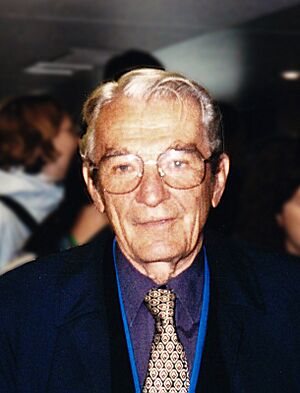Ivar Giaever facts for kids
Quick facts for kids
Ivar Giaever
|
|
|---|---|

Giaever in 2005
|
|
| Born |
Ivar Giæver
April 5, 1929 Bergen, Hordaland, Norway
|
| Died | June 20, 2025 (aged 96) |
| Citizenship |
|
| Alma mater | |
| Known for | Discovering tunneling in superconductors (1960) |
| Spouse(s) |
Inger Skramstad
(m. 1952; died 2023) |
| Children | 4 |
| Awards |
|
| Scientific career | |
| Fields | |
| Institutions |
|
Ivar Giaever (born April 5, 1929 – died June 20, 2025) was a scientist from Norway and the United States. He was a physicist, which is a scientist who studies how matter and energy work. In 1973, he won the Nobel Prize in Physics along with two other scientists, Leo Esaki and Brian Josephson.
Ivar Giaever received his part of the Nobel Prize for his amazing discoveries. He studied something called "tunneling phenomena" in special materials. These materials are called semiconductors and superconductors. His work helped us understand how tiny particles, like electrons, can move in unexpected ways.
Contents
A Scientist's Journey
Ivar Giaever studied mechanical engineering in Norway. He earned his degree in 1952 from the Norwegian Institute of Technology. In 1954, he moved from Norway to Canada. There, he started working for a company called General Electric.
Four years later, in 1958, he moved to the United States. He joined General Electric's main research center in New York. He became a citizen of the United States in 1964. While working at General Electric, he continued his studies. He earned his Ph.D. degree in 1964 from the Rensselaer Polytechnic Institute.
In 1988, Ivar Giaever left General Electric. He became a professor at the Rensselaer Polytechnic Institute. He also taught as a professor at the University of Oslo in Norway.
Studying Life Sciences
Later in his career, Giaever focused on biophysics. This field combines physics with biology to understand living things. In 1969, he spent a year studying biophysics at the University of Cambridge. He did this with a special grant called a Guggenheim Fellowship.
When he returned to the U.S., he kept working in biophysics. In 1993, he even started his own company. It was called Applied BioPhysics, Inc.
The Nobel Prize Discovery
Ivar Giaever's Nobel Prize-winning work happened in 1960. He was working at General Electric at the time. Another scientist, Leo Esaki, had found something interesting in 1958. Esaki discovered that electrons could "tunnel" through semiconductors.
Giaever then showed that this "tunneling" also happens in superconductors. Superconductors are materials that can carry electricity with no resistance. He did experiments with a very thin layer of oxide. This layer was placed between two pieces of metal. He showed that electrons could tunnel through this thin layer. This happened whether the metal was in a superconducting or normal state.
Giaever's experiments proved that superconductors have an "energy gap." This was a very important idea from the BCS theory of superconductivity. This theory was developed in 1957. Giaever's work inspired another physicist, Brian Josephson. Josephson then predicted the "Josephson effect" in 1962.
In 1973, Esaki and Giaever shared half of the Nobel Prize in Physics. Brian Josephson received the other half.
Other Awards and Honors
Besides the Nobel Prize, Ivar Giaever received other important awards. In 1965, he won the Oliver E. Buckley Prize. This award is given by the American Physical Society. He also received the Golden Plate Award in 1966. In 1974, he was given the Zworykin Award.
In 1985, he received an honorary degree from the Norwegian Institute of Technology. This university is now part of the Norwegian University of Science and Technology. He was also a member of the Norwegian Academy of Science and Letters.
Views on Climate Change
Ivar Giaever had different views on climate change. He expressed doubts about the scientific consensus on global warming. He once called it a "new religion." However, he did not present strong scientific evidence to support his position.
On September 13, 2011, he resigned from the American Physical Society. This happened after the organization stated that the evidence for damaging global warming was "incontrovertible."
Giaever also worked as a science advisor. He advised a group called The Heartland Institute. This group is a think tank that supports certain political ideas.
Personal Life
Ivar Giaever was married to Inger Skramstad. They were childhood sweethearts. They married in 1952. Inger passed away on September 12, 2023, at the age of 94. They had four children together.
Ivar Giaever passed away on June 20, 2025, at the age of 96.
Selected Books
- Giaever, Ivar (2016). "I Am The Smartest Man I Know": A Nobel Laureate's Difficult Journey, World Scientific. ISBN: 978-981-3109-17-9.
See also
 In Spanish: Ivar Giaever para niños
In Spanish: Ivar Giaever para niños

